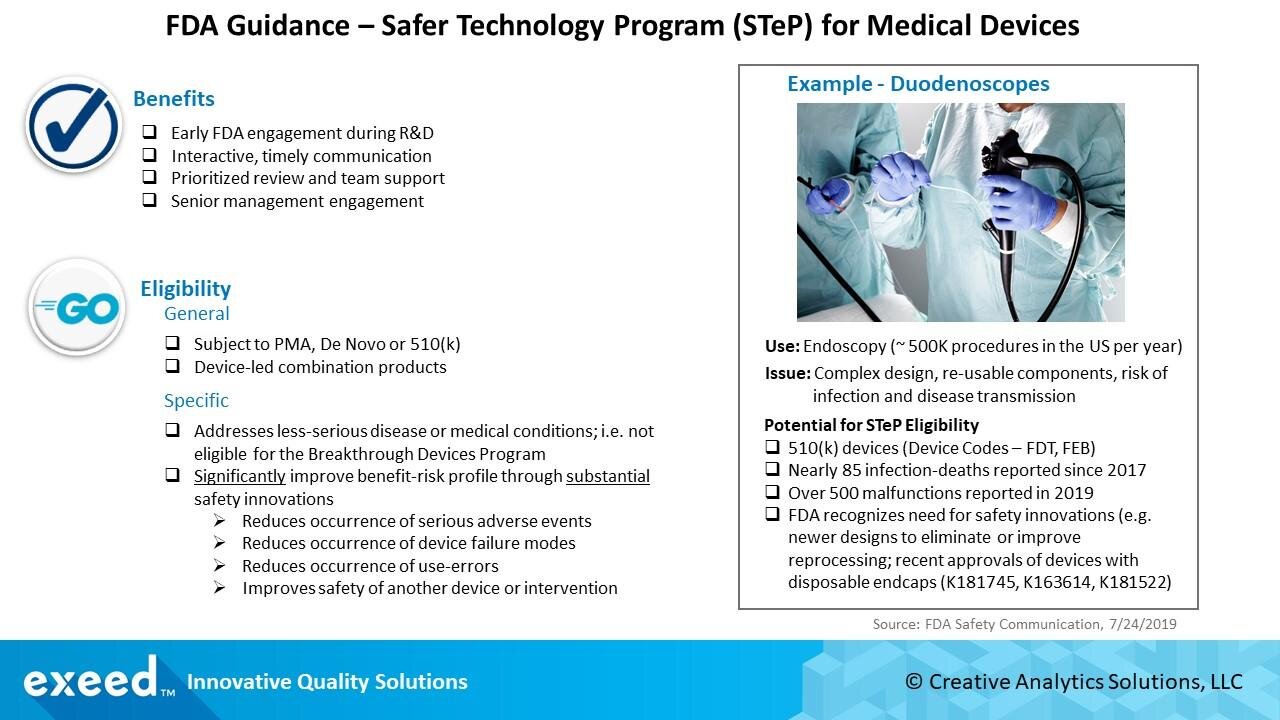A New FDA Guidance Encourages Development of Safer Medical Devices
Substantial safety innovations will benefit from FDA engagement during development and priority review of submissions
FDA has issued a draft guidance on the Safer Technologies Program (STeP) for Medical Devices to promote expedited development and regulatory review of safety innovations.
This is certainly a STeP in the right direction!
Unlike the Breakthrough Devices Program, which is designed to expedite development and pre-market regulatory review of devices that treat or diagnose life-threatening diseases or medical conditions, the STeP program will benefit devices which target less serious conditions. The idea is to encourage the industry to invest in development of devices with substantial safety innovations, which may not qualify for the Breakthrough Devices Program designation.
When implemented, the STeP program will offer significant benefits during product development through early, interactive and timely communication with FDA and prioritized review of subsequent regulatory submissions. This will allow medical device manufacturers to significantly reduce the development time and get to market faster. Patients and doctors will benefit from innovative products with a significantly better safety profile compared to existing products.
Safety of medical devices has been a chronic issue, although it has gained public visibility only recently due to several news reports in the media. Unlike pharmaceuticals, where blockbuster drugs attract constant scrutiny of the media and politicians, medical device industry is highly diverse and fragmented. There are thousands of medical devices in the market and the top 10 industry leaders account for less than half of the $390 billion estimated revenues in 2018. Although these devices have significantly improved the standard of medical care and quality of life for millions of patients, their safety record is not as impressive. According to a recent report from Associated Press, more than 1.7 million injuries and nearly 83,000 deaths related to medical devices were reported to the FDA between 2008 and 2017. This issue gained even more public awareness after the release of a Netflix documentary The Bleeding Edge. Even John Oliver recently covered this topic in a segment on his popular show Last Week Tonight with John Oliver.
This draft guidance is an example of FDA’s commitment to spur innovation towards safer medical devices as outlined in the Medical Device Safety Action Plan. A key requirement for a device to be eligible for the STeP designation is to incorporate an innovative technology feature, not simply improved labeling (Instructions for Use), to enable a substantial safety improvement. Examples of such innovations may include simpler, more robust designs, better materials, better software, simpler user-interface and error-proof operation. FDA intends to review the principles of operation of the device and preliminary data from non-clinical or clinical studies to assess the improvement in overall benefit-risk.
Similar to the Breakthrough Devices Program, the STeP program will have two phases – an initial phase to review and approve the designation of the device under this program, and a second phase to expedite device development and subsequent regulatory submissions. Review and approval of the designation request is expected to be completed within 60 calendar days after receiving the request. Examples of FDA support during the second phase include sprint discussions, review of Data Development Plan (DDP) and regular status update meetings outside of a formal regulatory submission review. The idea is to enable a more efficient development and review process for these devices through early engagement with FDA to get timely advice on design of clinical studies and other premarket/post-market data to facilitate the review of regulatory submissions.
The graphic below shows a summary of the eligibility criteria for the STeP designation and an illustrative example.
It is important to note that FDA expects these devices to “have a significant improvement in the benefit-risk profile relative to other available treatment or diagnostic alternatives for the disease or condition, where there are known serious adverse events and/or safety concerns”.
What is significant improvement? There is no specific numerical threshold in terms reduction in rate of occurrence, or type of injuries resulting from these known serious adverse events. One way to understand FDA’s thinking, and current concerns, is to review FDA Safety Communication or medical device recalls. Adverse events data on injuries and device malfunctions is also available in the MAUDE database, although it is not sufficient to establish rates of adverse events. Still, it is a good resource to gather baseline data on comparative products to evaluate potential opportunities for development of new products that could benefit from the STeP program. Another good source of information is manufacturer’s internal post-market surveillance data, including prior clinical studies, device registries and post-market clinical follow-up studies. Real World Data (RWD) from health records, claims and literature is also a potential source of baseline data. The business case for a potential new product should include analysis of this data and an estimate of the expected improvement in the benefit-risk profile of the device.
Healthcare is undergoing a huge transformation. Rising cost of healthcare and access to safe and effective treatment options, including medical devices, are driving changes in both regulatory and reimbursement policies (see our article on recent trends). Products with a superior patient safety performance will have a competitive advantage in faster regulatory approvals and in eligibility for reimbursement. Investing in technologies that significantly improve safety while delivering a higher, more differentiated clinical outcome, is not only good for the patients and providers, but also for business. This is the way forward for achieving and sustaining competitive advantage in future.
The draft guidance on the STeP program is a new opportunity for the industry. It is a promising new development, and a sign of the changing mindset at FDA.
Resources
FDA draft guidance on Safer Technology Program (STeP) for Medical Devices, September 2019
FDA guidance on Breakthrough Device Program, December 2018
Associated Press News Story on Medical Device Safety, November 2018
Netflix – The Bleeding Edge, 2019
Last Week Tonight with John Oliver – episode on medical devices, June 2019
Medical Device Safety Action Plan, September 2019


